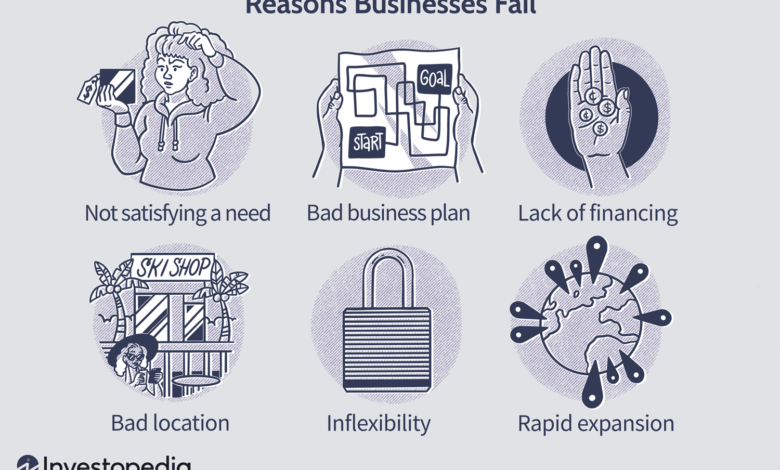Top 6 Reasons New Businesses Fail

The first years of a new business are often the hardest. New business owners must struggle to find capital, suppliers, and customers, all while trying to find enough income to pay their bills. In order to be successful, it is essential for new business owners to prepare for these risks.
According to the U.S. Bureau of Labor Statistics (BLS), approximately 20% of new businesses fail during the first two years of being open, 45% during the first five years, and 65% during the first 10 years. Only 25% of new businesses make it to 15 years or more. These statistics haven’t changed much over time, and have been fairly consistent since the 1990s. Though the odds are better than the commonly held belief, there are still many businesses that are closing down every year in the United States.
According to the BLS, entrepreneurs started 1,054,052 new businesses in the year ending March 2023. From the historical data, we can expect approximately 210,810 of these businesses to fail within the first two years. With the right planning, funding, and flexibility, businesses have a better chance of succeeding. We’ll go through some of the biggest mistakes that startups can make and figure out how to improve your chances of success.
Key Takeaways
- New businesses have the highest chances of failing, due to the combined pressures of raising capital, finding customers, and bringing in enough income to pay their bills.
- About 45% of new businesses fail within the first 5 years.
- Failure to research the market, and prepare a business plan are common reasons for business failure.
- Many companies do not raise enough starting capital, which is essential for new businesses without a reliable revenue stream.
- For more established businesses, there is also a danger of expanding too fast, without conducting enough market research.
Investopedia / Ellen Lindner
1. Not Investigating the Market
So you’ve always wanted to open a real estate agency, and you finally have the means to do so, but your desire to open the agency blinds you to the fact that the economy is in a down housing market and the area where you want to work in is already saturated with agencies, making it very difficult to break in. This is a mistake that will result in failure from the start. You have to find an opening or unmet need within a market and then fill it rather than try and push your product or service in. It’s a lot easier to satisfy a need rather than create one and convince people that they should spend money on it.
2. Business Plan Problems
A solid and realistic business plan is the basis of a successful business. In the plan, you will outline achievable goals for your business, how your business can meet those goals, and possible problems and solutions. The plan will figure out if there’s a need for the business through research and surveys; it will figure out the costs and inputs needed for the business, and it will outline strategies and timelines that should be implemented and met.
Once you have the plan, you should follow it. If you start doubling your spending or changing your strategies whimsically, you are asking for failure. Unless you have found that your business plan is overwhelmingly inaccurate, stick with it. If it is inaccurate, it’s best to find out what’s wrong with it, fix it, and follow the new plan rather than change how you do business based on quick observations.
The more mistakes you make, the more expensive your business will become and the greater the chance of failure. You may also be called to pivot when market conditions change drastically and impact negatively the chances of success based on the initial business plan. In this case, you revisit your plan and edit it fully based on the decided pivot.
According to a study by U.S. Bank, 82% of business failures are due to insufficient cash flow.
3. Too Little Financing
If you have started a company and things aren’t working out, and you have little capital and a struggling business, you’re not in a good position to ask for another loan. If you’re realistic at the beginning, you can plan to start with enough money that will last you to the point where your business is up and running and cash is actually flowing in.
Trying to stretch your finances at the beginning may mean that your business never gets off the ground, and you’ll still have a lot of cash to repay. Lean management strategy is warranted in this phase in particular but can be applied even after this phase. Try to think of multi-channels for funding and financing. Get educated about this area and be creative searching alternative sources of financing.
4. Bad Location, Internet Presence, and Marketing
A bad location is self-explanatory if your business relies on location for foot traffic. Just as dangerous, however, is a poor Internet presence. These days, your location on the internet and your social media strength can be just as important as your company’s physical location in a shopping district. An online presence will let people know that they can give you their business, so if the need is already there, the availability and visibility of your business is the next important step.
This is similar to marketing. Not only must you make sure that marketing reaches people, but it must also reach the right people. So make sure the type of marketing lines up with the audience you want to reach. Big billboards may not be the way to go for an internet company, just as online ads may not be the way to go for a heavy-construction business. If the need is already established, make sure you’re reaching the audience who needs your product or service.
5. Remaining Rigid
Once you’ve done the planning, established your business, and gained a customer base, don’t become complacent. The need that you’re fulfilling may not always be there. Monitor the market and know when you may need to alter your business plan. Being on top of key trends will allow you lots of time to adjust your strategy so that you can remain successful. One must only look at the music industry or Blockbuster video to know that successful industries can undergo huge changes.
6. Expanding Too Fast
Now that your business is established and successful, it’s time to expand, but you must treat the expansion like you’re starting all over again. If you’re expanding the reach of your business, make sure that you understand the areas and markets into which you’ll now be reaching. If you’re expanding the scope and focus of your business, make sure you understand your new products, service and intended consumer as much as you do with your current successful business.
When a business expands too fast and doesn’t take the same care with research, strategy, and planning, the financial drain of the failing business(es) can sink the whole enterprise.
Why Do Most Startups Fail?
Most new companies do not survive the startup phase, with 20% failing after the first year. Surveys of business owners suggest that poor market research, ineffective marketing, and not being an expert in the target industry were common pitfalls. Bad partnerships and insufficient capital are also big reasons why new companies fail.
What Is the Biggest Risk for Small Businesses?
One of the biggest hurdles for small businesses is running out of working capital. Since small businesses tend to have a low cash flow, they also have less financial cushion if they face economic hardship, and need to borrow or find investors when they face financial difficulty.
How Do You Find the Best Market for Your Industry?
Finding the right target market is a major hurdle for new companies, and entire industries exist to help market your products to the right consumers. Marketing professionals use focus groups, surveys, and in-person meetings with potential consumers to find out who their customers are, and what products they are looking for.
The Bottom Line
Though the rate of business failure in the first two years is around 20%, it doesn’t mean that you have to fail. Through research, planning, and flexibility, you can avoid many of the pitfalls of a new business and be a part of the approximately 25% that make it to 15 years and beyond.



